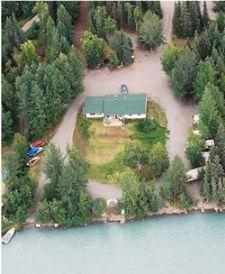Rockfishes (Sebastes sp.) are a diverse and important group of marine fishes. More than thirty species occur in Alaska's coastal waters, with at least twelve species ranging as far north as the Bering Sea.
General description: Adult rockfishes range in size from 5 to 41 inches with most species attaining sizes between 20 and 24 inches. These fish are characterized by having bony plates or spines on the head and body, a large mouth, and pelvic fins attached forward near the pectoral fins. The spines are venomous, and although not extremely toxic, can still cause pain and infection. Some species are brightly colored, and many are difficult to distinguish from one another. Rockfishes appear somewhat perch-like or bass-like, and are often called sea bass. All species have flesh that is delicious to eat. The most common species taken include the yelloweye, quillback, copper, dusky, and black.
Life history: Rockfish inhabiting the Gulf of Alaska can be separated into three ecological groups: (1) shelf demersal, or those species that live in the nearshore, shallower waters, in rocky bottom areas; (2) shelf pelagic, or those species that also live mostly in the nearshore, shallower continental shelf waters, but that spend much of their time up in the water column and off the bottom; and (3) slope, or those species that live in deeper waters, on the edge of the continental shelf.
All rockfish, or species of the genus Sebastes, are ovoviviparous. This means that these fish give birth to live young after internal fertilization.
Rockfishes are slow-growing and extremely long-lived. Black rockfishes (Sebastes melanops), a common pelagic species, become sexually mature at about 10 years of age and have been aged to 40 years. Yelloweye rockfish (Sebastes ruberrimus), a shelf demersal rockfish, are a longer-lived species, becoming sexually mature around 15 years of age and living in excess of 100 years. There have been unconfirmed ages of fish at 114 years. That means some of those rockfish were possibly alive during the Civil War and when the United States bought Alaska from Russia in 1867!
Members of some species, such as the yellowtail rockfish (Sebastes flavidus), do not wander very far and actually have a very strong preference for a specific site. If a fish is captured and relocated elsewhere, it will quickly return to its original home site.
Food habits: Rockfish feed on a variety of food items. Juveniles eat primarily plankton, such as small crustaceans and copepods, as well as fish eggs. Larger rockfish eat fish such as sand lance, herring, and small rockfish, as well as crustaceans.
Human use: Rockfish are a highly sought after and desirable food fish along the Pacific coast. In Alaska, rockfish have been taken commercially in fisheries targeting on other species such as halibut and salmon; however, in the 1960s, foreign trawl fisheries began harvesting in earnest certain deep-dwelling species like the Pacific ocean perch. The shelf demersal species of Southeast Alaska started to be exploited by local shore-based fishers just before 1980. The benefits of catching rockfish have not gone unnoticed by sport fishers, either. The interest in and harvest of these fish have both increased in recent years, although generally they are much less preferred than salmon and halibut. The majority of the recreational harvest of rockfish occurs near Seward in Resurrection Bay and in the Ketchikan and Sitka sport fisheries in Southeast Alaska.
Management: In most situations where there has been directed fishing effort on rockfish, be it commercial or recreational, stocks over time have been overharvested and even totally wiped out. Because rockfish take so long to become reproductively mature, and because many stocks are so site-specific and do not move around much, populations are extremely vulnerable to overexploitation.
Also, rockfish have a type of swim bladder that uses a special gas-producing and absorbing gland to change the volume of gas in the swim bladder, which is used to maintain buoyancy at different depths in the water. This type of swim bladder is easily damaged when a fish is subjected to sudden changes in water pressure, such as when it is brought to the surface. The gas gland does not have enough time to absorb the gas in the swim bladder as the gas expands with a decrease in water pressure. Consequently, the swim bladder gets so large that it is too large for the fish's body cavity and it literally explodes out through the mouth of the rockfish. Countless rockfish are wasted when they are caught incidentally by fishers seeking other fish and are thrown back in the water.
As the Alaska Department of Fish and Game came to realize that harvests in the commercial fisheries could not be sustained and certain populations were already overharvested, new regulations limiting the catch of rockfish were implemented.
Hopefully, there will be adequate information and management strategies to prevent Alaska's rockfish populations from going the way of most populations in other locations along the Pacific coast.
Text: Mark W. Schwan
Illustration: Ashley Dean
Revised and reprinted 1994






